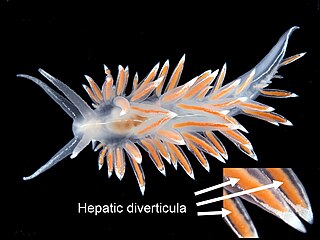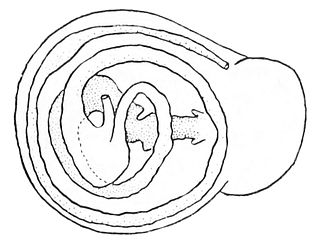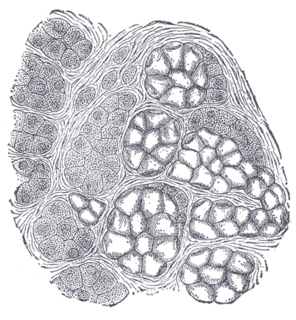The human body is the structure of a human being. It is composed of many different types of cells that together create tissues and subsequently organ systems. They ensure homeostasis and the viability of the human body.

The gastropods, more commonly known as snails and slugs, belong to a large taxonomic class of invertebrates within the phylum Mollusca, called Gastropoda. This class comprises snails and slugs from saltwater, from freshwater, and from the land. There are many thousands of species of sea snails and slugs, as well as freshwater snails, freshwater limpets, and land snails and slugs.

The pineal gland is a small endocrine gland in the brain of animals with backbones. The pineal gland produces melatonin, a serotonin-derived hormone which modulates sleep patterns in both circadian and seasonal cycles. The shape of the gland resembles a pine cone from which it derived its name. The pineal gland is located in the epithalamus, near the center of the brain, between the two hemispheres, tucked in a groove where the two halves of the thalamus join. It is also called the conarium, kônarion or epiphysis cerebri. The pineal gland is included among a group of specialized neuroendocrine brain structures called the circumventricular organs.

The retroperitoneal space (retroperitoneum) is the anatomical space in the abdominal cavity behind (retro) the peritoneum. It has no specific delineating anatomical structures. Organs are retroperitoneal if they have peritoneum on their anterior side only. Structures that are not suspended by mesentery in the abdominal cavity and that lie between the parietal peritoneum and abdominal wall are classified as retroperitoneal.
Peristome is an anatomical feature that surrounds an opening to an organ or structure. Some plants, fungi, and shelled gastropods have peristomes.

The mantle is a significant part of the anatomy of molluscs: it is the dorsal body wall which covers the visceral mass and usually protrudes in the form of flaps well beyond the visceral mass itself.
Terminologia Anatomica (TA) is the international standard on human anatomic terminology. It was developed by the Federative Committee on Anatomical Terminology (FCAT) and the International Federation of Associations of Anatomists (IFAA) and was released in 1998. It supersedes the previous standard, Nomina Anatomica. Terminologia Anatomica contains terminology for about 7500 human gross (macroscopic) anatomical structures. In April 2011, Terminologia Anatomica was published online by the Federative International Programme on Anatomical Terminologies (FIPAT), the successor of FCAT.

Carl Gottfried Semper was a German ethnologist and animal ecologist.

This glossary of entomology describes terms used in the formal study of insect species by entomologists.

The esophageal glands are glands that are part of the digestive system of various animals, including humans.

Nidamental glands are internal organs found in some elasmobranchs and certain molluscs, including cephalopods and gastropods.

As applied to mollusks, the New Latin term diverticulum is an anatomical feature. The term is most often encountered in the plural form as "diverticula", "hepatic diverticula", or "digestive diverticula", which are anatomical terms for organs which are visible from the outside of the body in a clade of sea slugs known as aeolid nudibranchs, marine opisthobranch gastropod molluscs.

The reproductive system of gastropods varies greatly from one group to another within this very large and diverse taxonomic class of animals. Their reproductive strategies also vary greatly, see Mating of gastropods.

The digestive system of gastropods has evolved to suit almost every kind of diet and feeding behavior. Gastropods as the largest taxonomic class of the mollusca are very diverse indeed: the group includes carnivores, herbivores, scavengers, filter feeders, and even parasites.

The excretory system of gastropods removes nitrogenous waste and maintains the internal water balance of these creatures, commonly referred to as snails and slugs. The primary organ of excretion is a nephridium.

The caudal mucous pit, or caudal mucous horn, is an anatomical structure on the tail end of the foot of various land snails and slugs, terrestrial pulmonate gastropod mollusks.

The suprapedal gland or mucous pedal gland is an anatomical feature found in some snails and slugs. It is a gland located inside the front end of the foot of gastropods.
Physoclisti are fishes that lack a connection between the gas bladder and the alimentary canal, the bladder serving only as a buoyancy organ.
This outline is provided as an overview of, and organized list of articles relevant to, the subject of gastropods :
















